 W
WThe Hawaii Audubon Society is a birding and bird conservation organisation in the American state of Hawaii. It was founded in 1939 by Charles Dunn, is based in Honolulu and is affiliated with the National Audubon Society. It has over 1,500 members throughout the state and produces a regular newsletter, ‘Elepaio.
 W
WThis list of birds of Hawaii is a comprehensive listing of all the bird species seen naturally in the U.S. state of Hawaii as determined by Robert L. and Peter Pyle of the Bishop Museum, Honolulu, and modified by subsequent taxonomic changes.
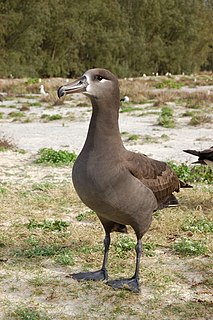 W
WThe black-footed albatross is a large seabird of the albatross family Diomedeidae from the North Pacific. All but 2.5% of the population is found among the Northwestern Hawaiian Islands. It is one of three species of albatross that range in the northern hemisphere, nesting on isolated tropical islands. Unlike many albatrosses, it is dark plumaged.
 W
WThe Laysan albatross is a large seabird that ranges across the North Pacific. The Northwestern Hawaiian Islands are home to 99.7% of the population. This small gull-like albatross is the second-most common seabird in the Hawaiian Islands, with an estimated population of 2.5 million birds, and is currently expanding its range to new islands. The Laysan albatross was first described as Diomedea immutabilis by Lionel Walter Rothschild, in 1893, on the basis of a specimen from Laysan Island.
 W
WThe short-tailed albatross or Steller's albatross is a large rare seabird from the North Pacific. Although related to the other North Pacific albatrosses, it also exhibits behavioural and morphological links to the albatrosses of the Southern Ocean. It was described by the German naturalist Peter Simon Pallas from skins collected by Georg Wilhelm Steller. Once common, it was brought to the edge of extinction by the trade in feathers, but with protection has recently made a recovery.
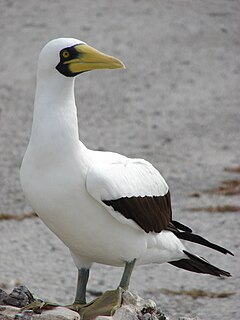 W
WThe masked booby, also called the masked gannet or the blue-faced booby, is a large seabird of the booby and gannet family, Sulidae. First described by the French naturalist René-Primevère Lesson in 1831, the masked booby is one of six species of booby in the genus Sula. It has a typical sulid body shape, with a long pointed yellowish bill, long neck, aerodynamic body, long slender wings and pointed tail. The adult is bright white with black wings, a black tail and a dark face mask; at 75–85 cm (30–33 in) long, it is the largest species of booby. The sexes have similar plumage. This species ranges across tropical oceans, except in the eastern Atlantic and eastern Pacific. In the latter, it is replaced by the Nazca booby, which was formerly regarded as a subspecies of masked booby.
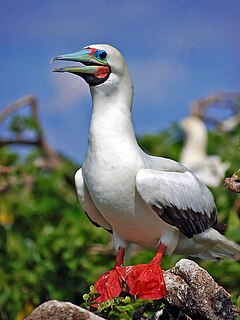 W
WThe red-footed booby is a large seabird of the booby family, Sulidae. Adults always have red feet, but the colour of the plumage varies. They are powerful and agile fliers, but they are clumsy in takeoffs and landings. They are found widely in the tropics, and breed colonially in coastal regions, especially islands. The species faces few natural or man-made threats, although its population is declining it is considered to be a least-concern species by the International Union for Conservation of Nature (IUCN).
 W
WThe nene, also known as nēnē and Hawaiian goose, is a species of bird endemic to the Hawaiian Islands. The official bird of the state of Hawaiʻi, the nene is exclusively found in the wild on the islands of Oahu, Maui, Kauaʻi, Molokai, and Hawaiʻi.
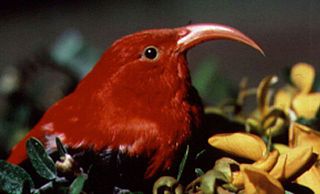 W
WHawaiian honeycreepers are small, passerine birds endemic to Hawaiʻi. They are closely related to the rosefinches in the genus Carpodacus. Their great morphological diversity is the result of adaptive radiation in an insular environment.
 W
WThe millerbird is a species of Old World warbler in the family Acrocephalidae. It has two subspecies, A. f. kingi and A f. familiaris. The latter, the Laysan millerbird, became extinct sometime between 1916 and 1923. The former, the critically endangered Nihoa millerbird, remains the only race left, inhabiting the small island Nihoa in Hawaiʻi, though it has since been reintroduced to Laysan. It is the only Old World warbler to have colonised Hawaiʻi, although there is no fossil evidence that the species ever had a distribution beyond these two islands.
 W
WThe olomaʻo is a small, dark solitaire endemic to Maui, Lānaʻi and Molokaʻi in the Hawaiian Islands. It is probably extinct. It grows up to 7 inches in length. The male and female of the species look similar. It is dark brown above and gray below with blackish legs. It is closely related to the other species of Hawaiian thrushes, the puaiohi, ʻōmaʻo, and the probably extinct kāmaʻo.
 W
WThe common myna or Indian myna, sometimes spelled mynah, is a member of the family Sturnidae native to Asia. An omnivorous open woodland bird with a strong territorial instinct, the common myna has adapted extremely well to urban environments.
 W
WThe black noddy or white-capped noddy is a seabird from the family Laridae. It is a medium-sized species of tern with black plumage and a white cap. It closely resembles the lesser noddy with which it was at one time considered conspecific. The black noddy has slightly darker plumage and dark rather than pale lores.
 W
WThe blue noddy is a seabird in the family Laridae. It is also known as the blue-grey noddy.
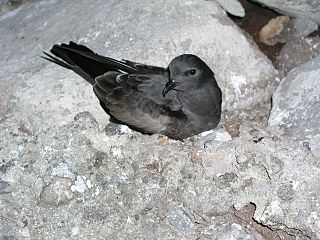 W
WTristram's storm petrel is a species of seabird in the storm petrel family Hydrobatidae. The species' common and scientific name is derived from the English clergyman Henry Baker Tristram; the species can also be known as the sooty storm petrel. Tristram's storm petrel has a distribution across the north Pacific Ocean, predominantly in tropical seas.
 W
WThe Bonin petrel is a seabird in the family Procellariidae. It is a small gadfly petrel. The species is native to the North Pacific Ocean. Its secretive habits, remote breeding colonies and limited range have resulted in few studies and many aspects of the species' biology are poorly known.
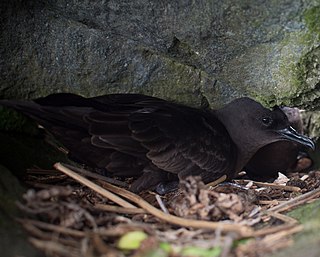 W
WBulwer's petrel is a small petrel in the family Procellariidae, and found in the genus Bulweria. This bird is named after the English naturalist James Bulwer.
 W
WThe sooty tern is a seabird in the family Laridae. It is a bird of the tropical oceans which sleeps on the wing, returning to land only for breeding- on islands throughout the equatorial zone.
 W
WThe red-tailed tropicbird is a seabird native to tropical parts of the Indian and Pacific Oceans. One of three closely related species of tropicbird (Phaethontidae), it was described by Pieter Boddaert in 1783. Superficially resembling a tern in appearance, it has almost all-white plumage with a black mask and a red bill. The sexes have similar plumage. As referenced in the common name, adults have red tail streamers that are about twice their body length. Four subspecies are recognised, but there is evidence of clinal variation in body size—with smaller birds in the north and larger in the south—and hence no grounds for subspecies.